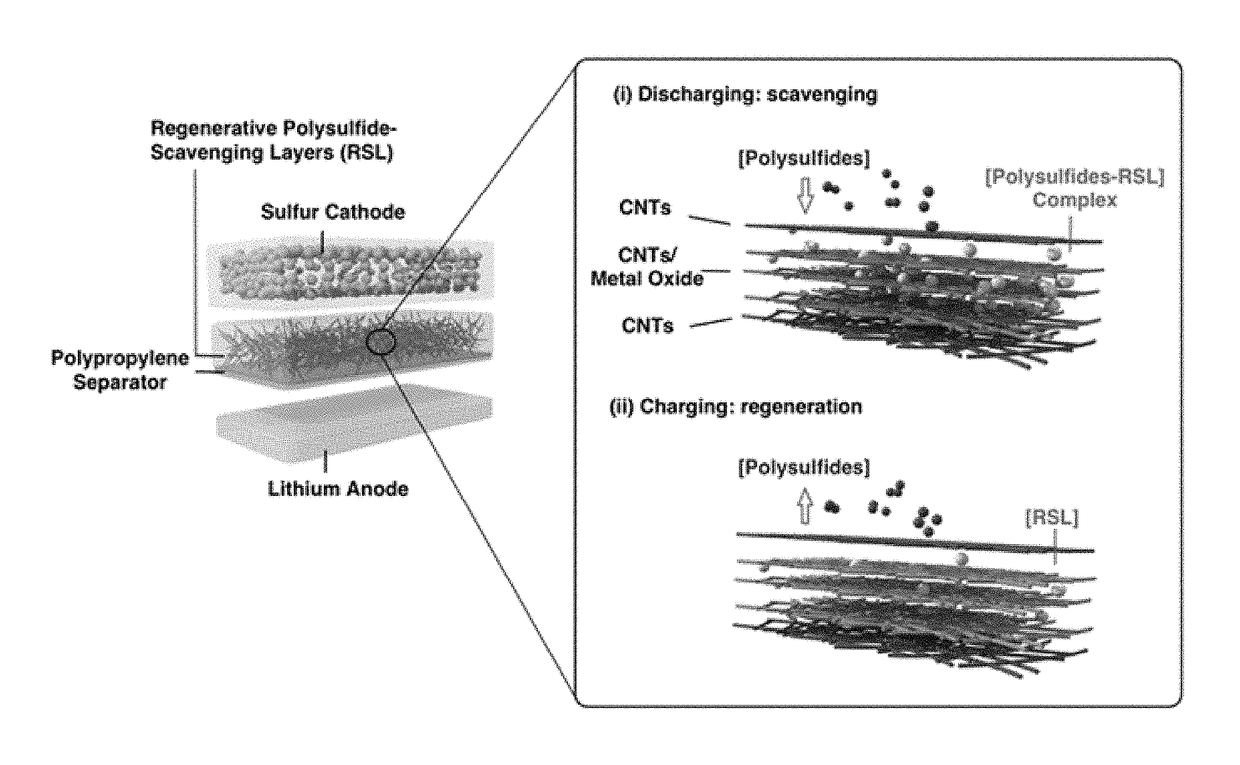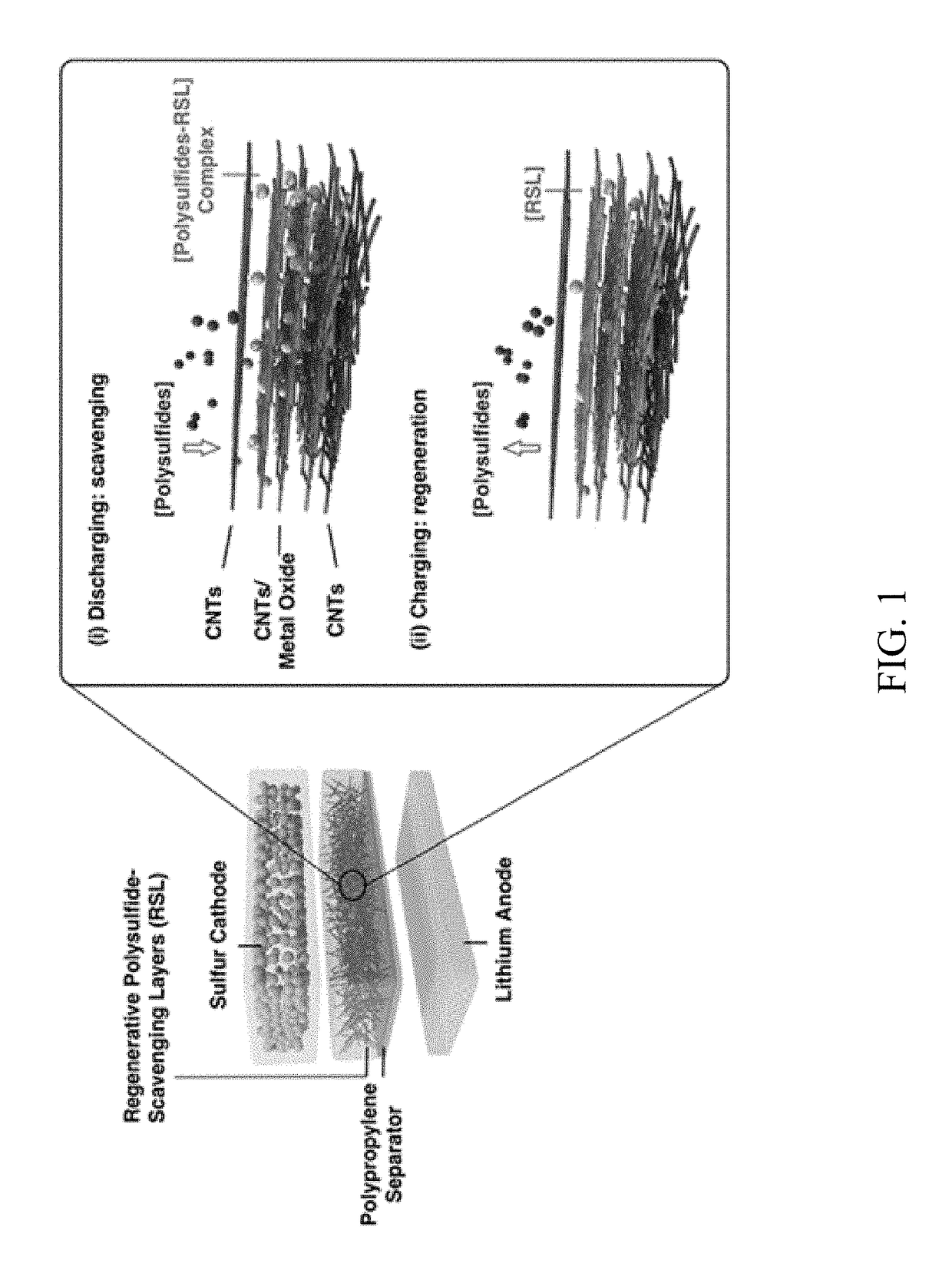Regenerative polysulfide-scavenging layers enabling lithium-sulfur batteries with high energy density and prolonged cycling life and methods of making same
a lithium-sulfur battery and polysulfide-scavenging technology, which is applied in the direction of secondary cell servicing/maintenance, sustainable manufacturing/processing, cell components, etc., can solve the problems of short cycling life, low gravimetric energy density, and hampered wide adaption of lithium-sulfur batteries, etc., to achieve low cost, compromise energy density and cycling life, and theoretical energy density high
- Summary
- Abstract
- Description
- Claims
- Application Information
AI Technical Summary
Benefits of technology
Problems solved by technology
Method used
Image
Examples
example 1
[0114]In this exemplary example, regenerative polysulfide-scavenging layers enabling lithium-sulfur batteries with high energy density and prolonged cycling life are shown. CNTs composites with different metal oxides are synthesized as follows.
[0115]Preparation of CNTs / Fe2O3 Composite:
[0116]1.2.5 g FeSO4.7F12O, 5 mL of polyethylene glycol 20,000 solution (50 g L−1) and 20 mg activated CNTs were dispersed in 42.5 mL DI water by sonication. 5 mL of diluted ammonia (2.5 wt %) and 0.1.35 mL H2O2 (28-30 wt %) were added into the above mixture under stirring. The mixture was then stirred for 1 hour at room temperature and underwent hydrothermal reaction at 160° C. for 8 h. After cooling to room temperature, as-formed composites were filtered, washed with distilled water, and dried at 60° C. overnight in vacuum.
[0117]Preparation of CNTs / CuO Composite:
[0118]0.94 g copper nitrate (Sigma-Aldrich), 1 g of P123 and 20 mg active CNTs were dispersed in 40 mL DI water by sonication. Then, 10 mL of...
example 2
[0128]FIG. 11 shows galvanostatic cycling performance of the cells with Celgard PP separator, with CNTs (2) RSL or CNTs / V2O5 RSL. All cells were cycled at 0.3 C rate for 3 cycles and then 1 C rate for 250 cycles. As shown in FIG. 11, for each of the cells with Celgard PP separator, with CNTs (2) RSL and CNTs / V2O5 RSL, specific capacity decreases as the cycle number increases. With the same cycle numbers, specific capacity for cell with CNTs (2) RSL is lower than that of cells with CNTs / V2O5 RSL, but higher than that of the cells with Celgard PP separator.
[0129]FIG. 12 shows capacity retention of the cells made with CNTs / V2O5 RSL prepared with different CNTs / V2O5 mass ratios but a fixed composite mass. As shown in FIG. 12, for each of the cells with ratios 1:1.33, 1:1.17 and 1:0.92 of CNTs / V2O5 RSL, specific capacity decreases as the cycle number increases. When the cycle number is larger than 0, with the same cycle numbers, specific capacity for the cells with a ratio 1:1.17 of CNTs...
PUM
| Property | Measurement | Unit |
|---|---|---|
| diameter | aaaaa | aaaaa |
| thickness | aaaaa | aaaaa |
| diameter | aaaaa | aaaaa |
Abstract
Description
Claims
Application Information
 Login to View More
Login to View More - R&D
- Intellectual Property
- Life Sciences
- Materials
- Tech Scout
- Unparalleled Data Quality
- Higher Quality Content
- 60% Fewer Hallucinations
Browse by: Latest US Patents, China's latest patents, Technical Efficacy Thesaurus, Application Domain, Technology Topic, Popular Technical Reports.
© 2025 PatSnap. All rights reserved.Legal|Privacy policy|Modern Slavery Act Transparency Statement|Sitemap|About US| Contact US: help@patsnap.com



